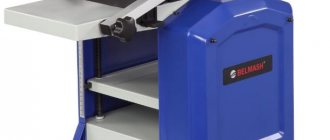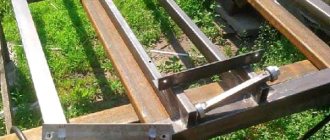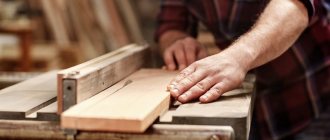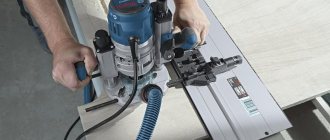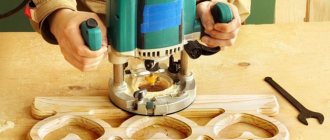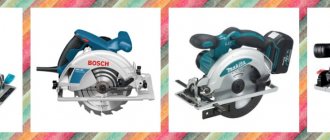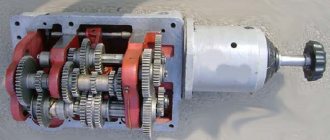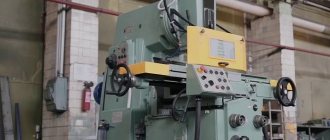A wood router is a cutting tool that can be used to cut, grind different types of wood, and also create complex, decorative patterns.
Depending on the model and design of the wood milling machine, industrial versions and manual samples are distinguished. The latter are intended for work in domestic conditions.
Purpose
Wood milling machines, depending on the model, can have different functionality. But there are standard operations that are performed on such a machine:
- finishing of the edges of the workpiece;
- production of molded products;
- applying complex, relief images to wood products;
- production of fastening elements, selection of grooves;
- figure cutting;
- production of cabinet furniture;
- preparation of various wooden blanks for subsequent processing.
All operations can be performed both on an industrial scale and at home.
Classification by type of material processed
The most common materials for milling are metals and wood.
Metal and woodworking milling cutters have significant differences in the number of spindle revolutions. Metal is processed at cutter speeds of up to 3000 rpm, wood is 10 times higher. Moreover, the higher the speed, the cleaner the woodworking. A metal cutter at such speeds will burn out or break.
In addition to these materials, modern machine tool industry offers milling cutters for processing almost all production materials. Woodworking machines can work with materials similar in density and strength to wood:
- MDF, chipboard, chipboard, OSB, fiberboard, plywood;
- some types of plastics and plastics;
- plexiglass and composite materials.
There are special machines for processing super-hard materials: granite, marble, other natural and artificial stones.
The image shows a stone router at work:
A separate direction is jewelry milling machines for processing semi-precious and precious stones and metals.
Simple milling machines from the 20th century are almost never produced today. However, they still work in many workshops and factories. Modern, CNC machines are being produced more and more. And there is the opportunity to choose the most suitable option. The entire world market for such equipment is open to the buyer. Modern equipment of this profile are also produced in Russia.
Areas of use
The technical characteristics and capabilities of wood milling machines allow them to be used in a wide variety of areas:
- production of wooden products for construction (railings, wall decor, baseboards, door frames, window frames);
- folk crafts: making toys, crafts, souvenirs;
- production of elements of furniture sets, their decoration.
Wood milling machines are used in all areas of woodworking, furniture production and construction. Small units are also used in domestic settings and in private workshops.
What can you do with a milling machine?
A wood router can be a great tool in your home workshop. You can perform a lot of different actions on it:
- ✓make panels for doors and kitchen facades;
- ✓make tenon joints in wooden door or window blocks;
- ✓cut mini-spikes on the edges of the parts;
- ✓make legs of various shapes for tables, poufs, etc.;
- ✓perform high-precision drilling of holes;
- ✓apply a pattern of varying complexity to a wooden plane;
- ✓process the edges of products in order to round them;
- ✓copy products according to an existing template;
- ✓grind the ends and bring the products to the required shape.
Based on the possibilities described above, we can conclude that a milling machine is an extremely necessary thing for a home, since it can easily replace a whole “fleet” of machines in a carpentry workshop.
Design features of stationary models
Professional wood milling machines are manufactured according to the most modern kinematic schemes. Depending on the model, the design of some components may differ, but the basics remain the same.
Milling table
A machine with a cutter creates strong vibration during operation. Therefore, the milling table must be reliable and stable. It is attached to the bottom of the tabletop. The clamps for the wood router are located flush with the table top.
bed
This is a monolithic part that is not subject to vibration and oscillation that occur during machine operation. Most often the frame is made of steel or cast iron.
Caliper
The support is located under the work table and the spindle shaft is attached to it. The caliper can be raised and lowered and adjusted so that it is in a comfortable position. The upper part of the support comes out through a hole in the table.
Spindle
The spindle box is the main part, which is designed to perform drilling, boring operations, and thread cutting. This mechanism consists of a body, a back plate and a cover. The spindle is fixed to the upper end of the shaft along with the cutting tool.
Cutting segment
Milling cutters, discs, knives, as well as drilling and cutting elements for milling work on wood can be used as cutting tools. Machining accuracy depends on the spindle speed. There are special grooves for fixing the tool stops.
Main types
The master can choose a wood milling machine that meets exactly his needs. All models have their own design features. There are many varieties, but there are a few main ones. Before purchasing, it is better to find out the features of the equipment offered.
CNC
These are modern machines that have advanced functionality and a number of advantages. These wood milling machines are additionally equipped with electronics.
Algorithm of operation of a CNC wood milling machine:
- At the first stage, a program is compiled using specialized software.
- Then a wooden blank is attached to the work table.
- Enter the program and do a test run.
- The wooden part is processed in accordance with the program.
If necessary, after a test run the program can be adjusted.
Copy
A wood milling machine with a copier is designed for processing and creating products with a large number of small parts and complex patterns. The copying unit allows for precise and accurate execution.
Processing identity is achieved through the use of special templates. The operator fixes the template, and the copying component copies the contour lines of the template. Such a unit can produce not only contour, but also volumetric copying.
Copying machines help perform the following operations:
- execution of complex patterns with edges located in different planes;
- engraving of shaped areas;
- inscription;
- creation of ornaments and various complex patterns.
Turning and milling
The turning and milling machine is designed to perform a wide range of operations. Most often, the turning component moves horizontally, and the milling component moves vertically. The unit performs operations from shaping to boring holes. Many machines are additionally equipped with equipment that increases productivity. For example, a bed extension.
Desktop
The power of a benchtop wood router is significantly higher than that of a simple hand-held electric tool. But at the same time, they are distinguished by a simple design and convenient system of use. Compact dimensions allow the machine to be used within a home workshop. The desktop wood router is capable of performing the following operations:
- making grooves;
- drilling and sawing wood blanks;
- creating patterns;
- creation of miniature components of furniture structures, decorative elements, slopes;
- drilling
The design of the desktop wood milling machine includes a small shaft.
Horizontal
The main thing is that the working movement of such a router is rotational, with the participation of the spindle and the cutter. The work table moves in vertical, longitudinal and transverse directions. The energy of movement is transferred from the electric motor to a box with gears, which regulates the speed.
Double sided
This is a universal wood milling machine used for a large number of operations. On such a unit you can process a profile of a wide variety of configurations. The main advantage of a wood milling machine is the ability to process on both sides simultaneously.
General information
Purpose
A wood milling machine was originally intended for profile and flat planing, for example, for processing edges, edges of workpieces, etc. However, the functionality of modern equipment is not limited to these tasks.
In particular, the machines allow you to perform the following operations:
- cut blanks or parts from solid wood;
- make a cut;
- select grooves and make holes;
- apply complex ornaments and three-dimensional designs.
As a result of this versatility, routing is perhaps the most common type of woodworking.
Volumetric milling
Design and principle of operation
Typically, a milling machine consists of the following main elements:
- beds;
- calipers;
- desktop;
- insert spindle;
- spindle shaft;
- cutters (cutting tools).
Main elements of the machine
The design of the machine may be different, however, in any case, the processing principle is that the cutting cutter rotates at high speed, cutting off excess wood. In this case, either the workpiece or the support itself performs reciprocating movements.
Varieties of woodworking center specifications
Depending on the tools that can be installed on the equipment, woodworking centers come in several types.
Rod
This cutter is suitable for all basic work performed by this type of equipment. The most common type of tool used both in domestic conditions and in industry.
Kromochny
This type of router is used for chamfering and rounding edges. Using an edge router, cut out recesses for furniture hinges. The same tool is used to make decorative grooves on the surface of wooden blanks. Perfectly processes products whose surface is covered with veneer or laminate.
Rotary
The equipment is designed for cutting through holes. Also successfully processes edges.
Lamellar
A lamellar router is used to form grooves on the surface of processed products. This is a highly specialized tool that performs a limited number of functions. Also, using this machine, specialists remove branches and resin pockets on the workpiece.
Additive
This is a separate type of tool designed for cutting paired holes for dowels. These units are needed exclusively in furniture production.
Safety measures when working on CNC machines: labor protection
When working on numerically controlled equipment, it is imperative to follow safety regulations. If you do not treat them responsibly, you can cause harm to your health. Almost 96% of accidents at work occur due to non-compliance with safety precautions.
Basic safety precautions when working with a CNC machine
Before access to the machine, the operator must undergo a full medical examination, as well as confirm knowledge of the rules for using the device. The assigned rank is indicated on the qualification certificate.
Equipment drives must be turned off every time a product needs to be removed or a workpiece needs to be installed. This must also be done when removing chips, changing tools and taking measurements.
It is forbidden to blow away shavings with your mouth or remove them with your hands. For this, special hooks and brushes are used.
Before starting work, the operator must know:
- major equipment malfunctions;
- machine device;
- shop floor rules;
- requirements of sanitary standards.
It is strictly prohibited to consume alcohol or drugs in the workplace. A drunk employee should not be allowed near the equipment.
Important criteria when choosing for a home workshop
When choosing a wood milling machine for a home workshop, it is important to decide what kind of work and to what extent this equipment will perform. Many technical characteristics and design features of a suitable machine depend on this.
Power
For home work, a lightweight manual router is suitable. If the work involves assembling furniture or construction, you will need a wood milling machine of a higher power class. For example, 400 W is quite enough for small jobs and drilling holes in soft wood.
Rotational speed
The speed at which the spindle rotates affects the productivity of a wood router. Depending on the number of rpm, you can judge the capabilities of the equipment. When choosing, you should take into account the uniqueness of the material that will be processed, as well as the width and depth of the finish.
Cutting stroke
The working stroke is the depth to which the working tool is capable of plunging into the material. For use in a household workshop, parameters of 20-50 mm are sufficient. The thickness of the parts that can be processed depends on how much of the process can be completed in a single movement of the tool.
Additional functions
It is worth paying attention to various additional options, the presence of which greatly facilitates the work process:
- Overload protection system. It turns on if the winding temperature has reached a critical value. Most often, this option is available on professional models. It works in different ways: the indicator may light up, and on some models the engine automatically turns off.
- Most routers are equipped with protection against unintentional start-up.
- Constant electronics controls the operation of the motor, stabilizes the spindle and maintains high-quality processing of the workpiece.
Most models have a soft start option, which minimizes damage to the workpiece.
Design features
Each individual design element also has its own technical characteristics, which are worth paying attention to when choosing a machine for your home workshop.
Sole
The class of the tool is determined by the quality of the casting of the sole. It is an important structural element and is made of metal. A stamped base is installed on inexpensive models. The top is covered with a removable cover. The opening size limits the maximum tool size that can be installed on the equipment.
Equipment fastening unit
Depending on the model, the possible equipment and types of cutters that can be installed on this equipment change. The more types of tools it is possible to install, the wider range of technological processes this unit is capable of performing.
Accessories
In addition to the main components, when choosing a cutter for a home workshop, it is important to pay attention to additional accessories. A stop is applied to the side of the base using two rigid steel crossbars. The rigid design ensures high-quality work.
When straight milling, precision must be maintained. The guide rail helps to do this. With its help you can mill holes with equal distances between them.
Maintainability
It is important that the machine parts and main components can last a long time and withstand the loads for which they are designed. Particular attention should be paid to the availability of parts for this equipment on sale. If after a breakdown there is nothing to replace the broken unit, you will simply have to throw it away.
Load level
Each model can withstand certain loads. This determines how long the equipment can be used and how reliable it is. If you plan to use the unit occasionally, then the load level will be very small.
Manufacturer
The highest quality equipment is most often from trusted manufacturers. There are brands that guarantee the quality of their products. Purchasing a little-known model means taking a risk.
Dealer
The seller is no less important. Many companies are official dealers of specific manufacturers. This will help you purchase a machine for your home workshop with the optimal set of functions and at an adequate price.
Price
In this case, each buyer decides for himself what price is right for him. But it is important to remember that good equipment cannot be cheap.
Features of working with a manual router
Finally, let’s look at the features of working with hand tools. It should be noted right away that for these purposes it is advisable to have a special table on which workpieces and guides can be fixed.
Milling with a hand router
This will simplify the task and increase the quality of work. The table is especially necessary for processing small parts. As guides, you can use straight rulers and curved templates, which can be cut out of thick cardboard or plywood.
templates for processing corners
So, the instructions for working with a household router look like this:
- First of all, you need to choose a suitable cutter. On our portal you can find detailed information about what types of cutters are and for what purposes they are used;
- then the cutter shank must be inserted into the chuck so that it plunges no more than 20 mm;
- next you need to turn the cartridge until it clicks and tighten the nut;
- the tool prepared for work must be installed opposite the template;
- then release the stopper and smoothly lower the tool until the cutting head touches the surface of the workpiece;
- after this, the mechanism must be lowered to the required depth and fixed in this position;
- then the router must be moved smoothly along the guide;
- if it is necessary to process a part at different depths, the operation is carried out in two passes;
Note! The router can only be moved in the opposite direction relative to the movement of the cutting head. Otherwise, the tool may be torn out of your hands, resulting in injury.
In the photo there is a special table for a router
That, in fact, is the whole milling process.
However, in order for work to be safe, the following rules must be observed:
- You can adjust the tool and attach the cutters only after disconnecting it from the electricity;
- since the cutters rotate at a very high speed, all processed parts must be securely fastened, otherwise they may break off and cause serious injury;
- It is necessary to hold the router firmly during operation and all movements with it should be performed smoothly, without sudden jerks;
- before starting work, you need to remove all foreign objects from the workplace;
- It is advisable to carry out processing of parts with glasses and a respirator, since during this process fine wood dust is formed that cannot be inhaled;
- At the moment the cutter touches the workpiece, the tool must be held especially tightly, as it can break out.
Note! When choosing the operating speed of the tool, the diameter of the cutting element should be taken into account. The larger it is, the lower the speed should be. Otherwise, the surface of the wood may become charred.
By following these simple rules, you can avoid troubles during work.
Tips for working and using at home
When choosing and using a wood milling machine, you must consider the following recommendations from experts:
- The ratio of engine power to the total weight of the structure should be taken into account.
- When purchasing, it is better to check the actual loading depth of the cutter.
- Be sure to test the rod cutter when purchasing.
- Before work, you need to arrange the work area, ensure the removal of dust and chips, and ensure normal lighting of the work area.
- When testing, it is important to pay attention to the build quality. If the unit exhibits excess noise and vibration, this indicates poor build quality.
Tooling must be within the recommended diameter and geometry. A wood milling machine is necessary both for a home workshop and for large-scale production. It performs a huge number of technological operations depending on the technical characteristics and additional equipment.
Types of routers for home
Its main purpose is to perform various types of wood processing, such as roughing, finishing and semi-finishing (for example: manufacturing simple parts, artistic cutting). To perform these works , you will need an actuating tool - various cutters, including:
- disk;
- corner;
- end;
- shaped;
- cylindrical;
- terminal
The variety of working tools is quite large, so everyone can use a home router in many types of processing of different materials.

